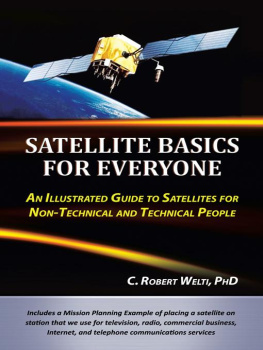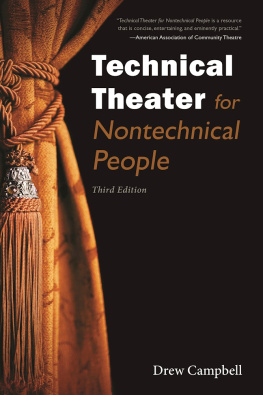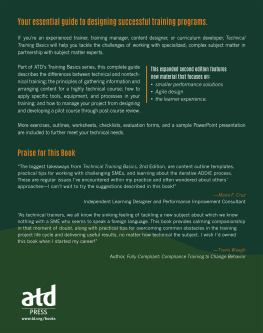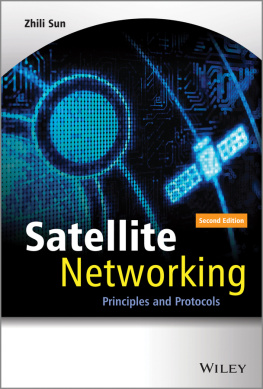SATELLITE BASICS
FOR EVERYONE
C. Robert Welti, PhD
iUniverse, Inc.
Bloomington
Satellite Basics for Everyone
An Illustrated Guide to Satellites for Non-Technical and Technical People
Copyright 2012 by C. Robert Welti.
Cover satellite image courtesy of NASA
Cover design by Sherri Murray
All rights reserved. No part of this book may be used or reproduced by any means, graphic, electronic, or mechanical, including photocopying, recording, taping or by any information storage retrieval system without the written permission of the publisher except in the case of brief quotations embodied in critical articles and reviews.
iUniverse books may be ordered through booksellers or by contacting:
iUniverse
1663 Liberty Drive
Bloomington, IN 47403
www.iuniverse.com
1-800-Authors (1-800-288-4677)
Because of the dynamic nature of the Internet, any web addresses or links contained in this book may have changed since publication and may no longer be valid. The views expressed in this work are solely those of the author and do not necessarily reflect the views of the publisher, and the publisher hereby disclaims any responsibility for them.
Any people depicted in stock imagery provided by Thinkstock are models, and such images are being used for illustrative purposes only.
Certain stock imagery Thinkstock.
ISBN: 978-1-4759-2593-7 (sc)
ISBN: 978-1-4759-2594-4 (hc)
ISBN: 978-1-4759-2595-1 (ebk)
Library of Congress Control Number: 2012908983
iUniverse rev. date: 05/29/2012
Original illustrations by C. Robert Welti
Contents

Disclaimer
The information contained in this book is intended to be educational in nature and not for any other purpose. The author disclaims personal liability, directly or indirectly, for advice of information presented within. Although the author has prepared the manuscript with utmost care and diligence and has made every effort to ensure the accuracy and completeness of the information contained within, he assumes no responsibility for errors, inaccuracies, omissions, or inconsistencies. The Web is constantly changing and improving, so the author cannot guarantee that every reference will always remain constant.

Acknowledgement
Publication of this book would not have been possible without the help and support of several members of my family. My daughter, Sherri, who is a wonderfully talented professional graphic artist, designed the book cover. My wife, Kem, reviewed writing of the book and contributed many valuable comments and suggestions to enhance its presentation for clarity and understanding. She was my north star for making this book for everyone. My friend Suzanne Villarreal, who is a talented expository writing teacher, reviewed this book. She also gave me valuable information and advice on publishing this book in addition to being an ardent cheerleader. Numerous other family members and friends contributed many suggestions and encouragement. Thank you all!

I was inspired to write this book after a presentation I gave to a group of retired men who have diverse backgrounds and work experiences, and know little about satellites. My talk included a hypothetical mission-planning task for placing a satellite in orbit and supporting it to perform its on-orbit mission. Response to the presentation was overwhelming, and many of the members wanted more information.
From the beginning, I realized that my presentation had to be simple, clear, interesting, and entertaining so I included abundant illustrations, familiar terminology, and simple explanations. For Satellite Basics for Everyone, Ive developed even more of these materials, and hope to make satellite science as clear and understandable to you as it was for my audience of seniors, whatever your background, age, or work experience.
This book answers the following questions about satellites: Whats a satellite? What are satellite missions? Who owns and operates satellites? Who builds satellites? How many satellites are in orbit? How close do they come to each other? How much debris is in orbit? Whats the risk of collision? How do you launch satellites into space? How do you control satellites? How much do satellites cost? How do you put a satellite in orbit? What forces perturb the satellite? How do you keep a satellite in orbit? How do you keep the satellite oriented and pointing in the right direction? When is the best time to make orbit maneuvers? How much propellant do you need for corrections and maneuvers? What determines satellite lifetime? Whats the future of satellite technology?
I wrote this book for grade school, high school, and college students, aerospace workers, and people who have curious minds. The main objective of this book is to stimulate a broad interest in engineering and science.
While looking at my book, my eight year old grand-daughter, Julia, asked, Are they going to replace the Hubble Space Telescope? (The book says its estimated lifetime is until 2014.) She also asked, What does M stand for? I replied, It stands for millions of dollars when used with the $ sign. Then she exclaimed, Wow! Satellites sure cost a lot of money. She continued to ask questions. My friend cant wait to get a copy of it for her thirteen year old grandson who is interested in science. Another friend who is involved in getting free books for grade school students wants my book. These examples show how it is a learning tool and a way to stimulate interest in satellites and science for grade school students.
As young students, my friends and I found it difficult to decide on career fields because we didnt have sufficient information. This book gives high school and college students an introduction to possible career field options.
In hindsight, development of satellites would have been easier and more efficient if all members of the satellite team had had a basic overall understanding of satellites and how they work. This reflection is especially true for the times when I worked on the international Intelsat V communications satellite and other satellite programs. Also, I noticed this same lack of overall satellite understanding when I managed satellite software development and maintenance for the U. S. Air Force Satellite Control Facility, and performed proposal evaluation and system engineering for U. S. Air Force satellite programs while at the Aerospace Corporation.
On one occasion while on an airplane, I was seated next to a United States Air Force Airman who was returning from a class on satellite intelligence resources. We discussed my book and he said, I wish I had had your book before I took my class.
I showed my book to family and friends who knew little about satellites and how they worked. They said they learned a lot.
In summary, I wrote Satellite Basics for Everyone as clearly and understandably as possible for a wide audience. I hope you enjoy it.
C. Robert Welti

An artificial satellite is an object which has been placed into orbit by human endeavor. Such objects are called artificial satellites to distinguish them from natural satellites such as the moon. This book gives an introduction and overview to artificial satellites that orbit the earth and how they are placed in orbit and kept there to perform their missions.
Next page















